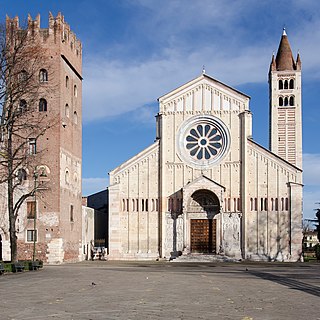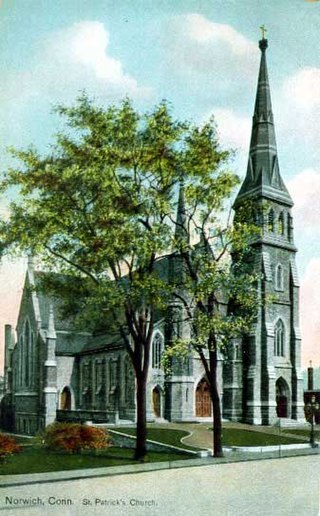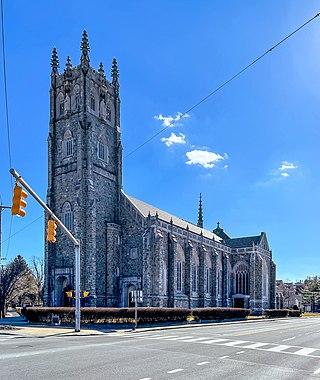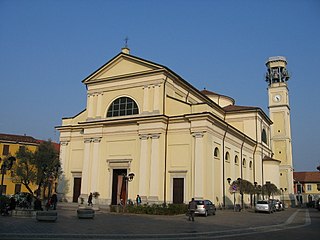
The Piazza dei Miracoli, formally known as Piazza del Duomo, is a walled 8.87-hectare (21.9-acre) compound in central Pisa, Tuscany, Italy, recognized as an important center of European medieval art and one of the finest architectural complexes in the world. It was all owned by the Catholic Church and is dominated by four great religious edifices: Pisa Cathedral, the Pisa Baptistery, the Leaning Tower of Pisa, and the Camposanto Monumentale. Partly paved and partly grassed, the Piazza dei Miracoli is also the site of the Ospedale Nuovo di Santo Spirito, which now houses the Sinopias Museum and the Cathedral Museum.

Patrick Charles Keely was an Irish-American architect based in Brooklyn, New York, and Providence, Rhode Island. He was a prolific designer of nearly 600 churches and hundreds of other institutional buildings for the Roman Catholic Church or Roman Catholic patrons in the eastern United States and Canada, particularly in New York City, Boston and Chicago in the later half of the 19th century. He designed every 19th-century Catholic cathedral in New England. Several other church and institutional architects began their careers in his firm.

Prato Cathedral, or Cathedral of Saint Stephen, is a Roman Catholic cathedral in Prato, Tuscany, Central Italy, from 1954 the seat of the Bishop of Prato, having been previously, from 1653, a cathedral in the Diocese of Pistoia and Prato. It is dedicated to Saint Stephen, the first Christian martyr.

Santa Maria presso San Satiro is a church in Milan. The Italian Renaissance structure (1476–1482) houses the early medieval shrine to Satyrus, brother of Saint Ambrose. The church is known for its false apse, an early example of trompe-l'œil, attributed to Donato Bramante.

Holy Trinity Church is a historic church of the Roman Catholic Archdiocese of Chicago located at 1118 North Noble Street. It is a prime example of the so-called 'Polish cathedral style' of churches, in both its opulence and grand scale. Along with such monumental religious edifices as St. Mary of the Angels, St. Hedwig's or St. John Cantius, it is one of the many Polish churches that dominate over the Kennedy Expressway in the Pulaski Park neighborhood of Chicago.
St. Ladislaus - historic church of the Roman Catholic Archdiocese of Chicago located in Chicago, Illinois.

The Basilica di San Zeno is a minor basilica of Verona, northern Italy constructed between 967 and 1398 AD. Its fame rests partly on its Romanesque architecture and partly upon the tradition that its crypt was the place of the marriage of Shakespeare's Romeo and Juliet.

St. Andrew's Catholic Church is a Catholic church in Pasadena, California. Founded in 1886, it is the oldest Catholic parish in Pasadena and one of the oldest in Los Angeles County. Its Romanesque Revival campanile bell tower is visible for miles and is one of the landmarks of Pasadena. The interior of the current church, built in 1927, was modeled after the Basilica of Santa Sabina in Rome, while the façade was modeled after the church of Santa Maria in Cosmedin, down the hill and slightly upriver from Santa Sabina.

The St. Charles Borromeo Church is a former Roman Catholic parish church in Woonsocket, Rhode Island, located on North Main Street. The parish of St. Charles was canonically suppressed January 12, 2020 and the congregation merged with that of the Church of All Saints, another parish of the Diocese of Providence, although the church remains open as an alternative worship space.

St. Joseph's Church is a historic church located at 1355 North Main Street in Fall River, Massachusetts. Designed by notable church architect Patrick C. Keely, it was built in 1880 in the Gothic Revival style. It was added to the National Register of Historic Places in 1983, the same day as St. Patrick's.

St. Charles Borromeo Roman Catholic Church is a church located at the corner of Baldwin Avenue and St. Paul Avenue in Detroit, Michigan. The church address is 1515 Baldwin Street; The church address is 1515 Baldwin Street; the parish rectory is located at 1491 Baldwin and sits next door to the church. The complex was listed on the National Register of Historic Places in 1989.

The Church of the Immaculate Conception on the motherhouse grounds of the Sisters of Providence of Saint Mary-of-the-Woods is a large Italian Renaissance Revival-style church constructed of Indiana limestone at Saint Mary-of-the-Woods, Indiana. The cathedral-like structure, which is the fourth church/chapel of the Sisters of Providence since their arrival at Saint Mary-of-the-Woods in 1840. Construction for the church began in 1886; its exterior was completed in 1891 and the interior was completed in 1907. The church was consecrated on October 23, 1907, and continues to serve as a place of daily worship services that are open to the public. The church also houses the shrine and tomb of Saint Mother Théodore Guérin, foundress of the Sisters of Providence of Saint Mary-of-the-Woods. Our Lady of Sorrows Chapel (1905) was erected in the crypt beneath the church.

James Murphy, FAIA, (1834–1907) was an Irish-American architect active in late-nineteenth- and early twentieth-century New England, who designed numerous Roman Catholic churches and related structures.

Ambrose J. Murphy (1869–1949) was an American architect whose practice was based in Providence Rhode Island. He was a specialist in ecclesiastical work and, in a career that spanned over 40 years, designed many buildings for the Roman Catholic Diocese of Providence Rhode Island and Fall River Massachusetts.

The Minor Basilica and National Shrine of Saint Lorenzo Ruiz, also as Our Lady of the Most Holy Rosary Parish and commonly known as Binondo Church, is located in the district of Binondo, Manila fronting Plaza San Lorenzo Ruiz, in the Philippines. It is under the jurisdiction of the Archdiocese of Manila. The church was founded by Dominican priests in 1596 to serve their Chinese converts to Christianity. The original building was destroyed in 1762 by British bombardment. A new granite church was completed on the same site in 1852 however it was greatly damaged during the Second World War, with only the western façade and the octagonal belfry surviving.

San Carlos Borromeo Parish Church, commonly known as Mahatao Church, is a Roman Catholic church located in Mahatao, Batan Island, Batanes, Philippines. It is under the jurisdiction of the Territorial Prelature of Batanes. The church's titular is Saint Charles Borromeo whose feast is celebrated every November 4. Its beauty and excellent state of preservation made it a National Cultural Treasure by the National Museum of the Philippines on July 31, 2001.

Our Lady of Pompeii Church, or more formally, the Shrine Church of Our Lady of Pompeii, is a Catholic parish church located in the South Village neighborhood of Manhattan, New York City, in the United States. The church is staffed by Scalabrini Fathers, while the Our Lady of Pompeii School is staffed by Apostles of the Sacred Heart of Jesus. It is located across from Father Demo Square, which is named for the church's third pastor, Antonio Demo.

The Church of Saint Bartholomew is the cathedral and the oldest parish in Brugherio, Italy. It houses relics of the three Magi. It is characterised by its relatively high bell tower measuring 36.8 metres (121 ft).

The St. Catherine of Alexandria Church is a Roman Catholic church in the Tabán quarter of Budapest, Hungary. It is the parish church of the Tabán Parish which also comprises parts of Gellért Hill and Naphegy. The church is a listed monument that was built in Central European Baroque style between 1728 and 1777. It was reconstructed several times in the 19th–20th centuries.


















